Board Business
Time to grin and bear it for CEO
September 25, 2014
This is the story of Bill and the three bears.
Last Sunday afternoon, the county’s chief executive officer was pursing his usual weekend pasttime—terracing his sprawling, hilly backyard with bricks—9,000 of them , so far—when his wife bolted out of the house. She announced that three sheriff patrol cars were blocking the driveway and that officials from the state Department of Fish and Wildlife were there, too.
Why the commotion? A mother bear and two cubs had shimmied up an oak tree in front of Fujioka’s house in the tiny city of Bradbury, nestled at the base of the San Gabriel Mountains near Monrovia. They’d been spotted on a busy street in the area and were being guided back towards the mountains by authorities when the parched and hungry animals decided to hole up at Fujioka’s place.
“Holy smokes,” Fujioka exclaimed as he saw for himself what was unfolding out front.
Wildlife officials told Fujioka that because of the severity of the drought, the bears had wandered from the mountains looking for food and water. “It was sad,” Fujioka said. “The mother’s fur looked bad and the cubs looked malnourished.”
At one point, Fujioka said, he started walking towards the tree when the mama bear “started hitting the branches.”
“Back up!” a wildlife official told Fujioka. “She’s warning you. If you keep going, she’ll come down that tree and charge you.”
After more than an hour, the bears did climb down but quickly jumped Fujioka’s fence and high-tailed it into another tree, a birch that was even closer to the house. “From my bedroom window,” the CEO recalled, “I could look at the bear eyeball-to-eyeball.”
By now, the news crews had arrived, hoping for footage of the bears’ descent.
As they waited, a reporter for KABC-TV interviewed Fujioka, who admittedly was “as filthy as could be” from his backyard brick work.
Usually when he makes the news, Fujioka is seen unveiling the county’s budget or taking part in other official business. This time, his name was misspelled as “Fugioka” and there was no mention of his position with the county. He was just another neighborhood man in the news. And that neighborhood is no stranger to attracting media attention for its occasional bear visitors. A few years ago, one made headlines for taking a dip in a resident’s hot tub.
On Sunday, in the end, the bears waited out almost everyone—the deputies, the fish and wildlife people, even the news hounds. Everyone except Fujioka and his wife, Darlene Kuba. After more than two hours in the branches, at about 4 p.m. the trio inched down and literally hit the bricks, ambling across Fujioka’s prized, terraced backyard and then back into the hills—leaving Darlene as the lone chronicler of the moment. Here are some of her pictures of the bears on the lam:
A Grand party—unless you were green
September 11, 2014
The fans were ecstatic and the downtown boosters were declaring victory.
But as Grand Park awoke this week from its most ambitious gathering so far, it was clear that for at least one constituency, last weekend’s Made in America extravaganza was no party.
Ladies and gentlemen, give it up for the poor shrubbery.
Although cleanup crews said this week that the new park rebounded surprisingly well from the 70,000-plus fans who stomped, jumped and danced their way through the Civic Center park over Labor Day weekend, a damage assessment prepared for the county offered the sordid details.
Some 10,000 square feet of lantanas, bougainvillea, aloes, drought-tolerant grasses and other greenery—drawn from around the world to reflect the diversity of L.A.—will have to be pulled out and replaced in the aftermath of the two-day concert. In the section of the park closest to the main stage in front of City Hall, more than 1,500 separate plants, many of which had been growing into maturity for nearly two years, must be replaced.
“The trees weren’t too damaged, but a lot of the plants in the planters were completely smashed and broken,” said Sergio Hernandez, manager at ValleyCrest Cos., the Calabasas-based landscaping contractor that maintains the 12-acre park for the county. “It almost looked like people were standing on some of the shrubs.”
The botanical casualties were estimated by ValleyCrest at about $50,000 park-wide. Hernandez said the new plants will probably take until next spring to reach the same size as they were before concertgoers arrived.
Live Nation, the concert promoter, is contractually obligated to cover the costs of the landscaping and other damage, including the replacement of six thick tiles in the popular Arthur J. Memorial fountain splash pad, which were broken during the construction and tear-down of a stage.
Despite the damage, the event—curated by rapper Jay Z and headlined by such international names as Kanye West, John Mayer and Steve Aoki—won wide praise from its many boosters, including Los Angeles Mayor Eric Garcetti. Among other things, it generated some $600,000 in fees for the county and $500,000 for the city, while showcasing Grand Park as a potential rival to the Coliseum, the Rose Bowl and other signature Southern California gathering spaces.
A spokeswoman for the mayor said his office still is assessing last weekend’s economic impact, but press interviews with downtown merchants indicated that their businesses had gotten a much-needed boost, and park planners said the event, overall, was a net benefit to the public.
“You want the park to be used, and you want it to be used for different things,” said Dawn McDivitt, who managed the development of Grand Park for the county Chief Executive Office before leaving to become chief deputy director of the Natural History Museum of Los Angeles County this year.
“When a big ticketed event actually rents the park, you get not only the side benefit of additional revenue for more public programs, but also the ability to reach a different type and age of audience, who will come down and enjoy other, free, events at the park later.”
But, she added, “a big, ticketed event also can be a concern because the park was established for the public, and you have to make sure that the public will still be able to enjoy it afterward.”
Grand Park officials said that the landscaping should be restored by next week, along with the completion of repairs on the fountain and a damaged irrigation line.
The preliminary assessment, prepared by ValleyCrest, estimated that $38,898 in damage had been caused near the park’s main event lawn, between Broadway and Spring Street.
Irrigation repairs and plant replacement elsewhere in the park will probably cost an additional $14,000, said Christine Frias, a program manager in the CEO’s office who coordinated the county’s Made in America involvement. She said the county was able to keep landscape costs lower by fencing planters that weren’t in the flow of foot traffic.
Grand Park Director Lucas Rivera said that, given the size and scope of the event, the impact was considerably lighter than anyone had anticipated.
“Made in America provided Angelenos with amazing entertainment and put Grand Park on the national stage,” said Grand Park Director Lucas Rivera. “With any event held in a public space, and with the amount of people who attend, there’s always going to be some wear and tear on the venue.”
Posted 9/4/14
A park vote to keep the green flowing
August 6, 2014
From the Malibu Pier to trails running through the Santa Monica Mountains, from a dog park in La Crescenta to a skate park in Downey, two L.A. County park measures have generated nearly $1 billion in improvements over the past two decades for some of the region’s best-loved gathering places, great and small.
The measures—Proposition A in 1992 and a follow-up initiative known as “Baby A” in 1996—have helped to fund 1,545 projects across the county including “tot lots,” tree planting, swimming pools, soccer fields, bikeways and fitness gardens, along with facilities for seniors and youth, wildlife habitat projects and graffiti abatement services.
Among the measures’ most broadly visible success stories: a new shell installed at the Hollywood Bowl, a county park, in 2004; the extensive restoration of the Griffith Observatory, which reopened to the public in 2006; and expansion of the Kenneth Hahn State Recreation Area, with amenities including a play area and ball fields. Prop. A funding also has helped transform El Cariso Community Regional Park in Sylmar, which now boasts new features including soccer fields and a 15,000-square-foot community center and gymnasium. And it is allowing kids to make a splash this summer in the new Olympic-sized pool at Belvedere Park in East Los Angeles.
But the flow of green amenities to parks in L.A. County’s unincorporated areas and its 88 cities could be coming to an end, with Prop. A set to expire next June 30. (Its 1996 counterpart will finish in 2019.)
Concerned about derailing a successful program of investing in local parks and recreation facilities, the Los Angeles County Board of Supervisors decided this week to place on the November ballot a measure that would essentially carry on the 1992 Prop. A for 30 more years, generating a similar $53 million per year.
“We need to do this if we want to keep the momentum going,” said Supervisor Zev Yaroslavsky, who along with Supervisors Don Knabe and Gloria Molina voted to place the measure on the Nov. 4 ballot. “The public has benefitted from this. They like the parks that have been built. They like the recreational opportunities that have been provided. I don’t think they want to see this come to a grinding halt on June 30 of this coming year.”
But Supervisor Michael D. Antonovich, who joined Mark Ridley-Thomas in opposing the action, said it was too soon to place what he called a “half-baked tax” before the voters, especially since Prop. A ’96 is continuing for several more years and some unspent funds remain in Prop. A coffers.
Russ Guiney, the county’s director of Parks and Recreation, acknowledged that there is a current balance of $154 million in Prop. A funds, but said $20 million of that is committed to upcoming projects. Unless the proposed continuation of Prop. A passes, the remaining funds will be spent down rapidly on park projects and maintenance demands that run around $55 million annually, Guiney said.
The average homeowner currently is assessed $13 a year for Prop. A ’92 and $7 annually for Prop A. ’96, for a total of $20 a year. The measure now heading to the Nov. 4 ballot would replace the Prop. A ’92 assessment with a flat tax of $23 a year per parcel. If passed by the required two-thirds of county voters, that would bring the average homeowner’s total tab for park improvements to $30 per year.
Guiney noted that 64% of voters approved the 1992 measure, and even more—65%—voted in favor of the 1996 proposition.That bodes well, he said, especially since so many projects built with funds from the previous parks measures are now visible and being used enthusiastically by the public.
“I think the voters understand and appreciate this, based on past history,” he said. “We’re optimistic.”
Posted 8/6/14
County’s $840 million reform plan
June 17, 2014

The county, which pays millions annually for health care for retirees and their dependents, will save substantially in the years ahead.
In a move expected to save hundreds of millions of dollars in the decades to come, the Los Angeles County Board of Supervisors on Tuesday approved historic reforms in the way it pays for county retirees’ health care insurance.
County officials said the changes could save $840 million over the course of the next 30 years. Under the plan—which applies to those hired after July 1, not to current workers—the county will reduce the subsidies it provides for retirees to purchase health care insurance. The changes approved by the board also require retirees who are eligible for Medicare to enroll in the federal program; the county subsidy will be applied to a Medicare supplement plan.
The savings are projected be considerable. Currently, the county pays up to $1,953.41 a month to subsidize health care benefits for a retiree and his or her family. Under the new plan, a retiree under the age of 65 would receive an individual monthly subsidy of up to $918.46, which will be reduced to $370.89 once the retiree reaches 65 and can be covered under Medicare. The new plan is based only on individual coverage, but retirees can still purchase insurance for their dependents at their own expense.
“This represents one of the most significant improvements to our retiree health care benefit since the 1980s. It reduces our unfunded liability by 20%,” said William T Fujioka, the county’s chief executive officer. “It speaks to our board’s fiscal responsibility and fiscal discipline, and it’s a move that will help ensure our future financial viability.”
Fujioka said the support of county labor groups had helped make the new retiree health plan a reality.
“They were with us 100%,” Fujioka said. “We went to the table and negotiated this change, and they joined us in presenting this change to our L.A. County retirement board. As a consequence, we got a unanimous vote.”
The county currently pays about $487.8 million a year for retiree health care—with that obligation coming off the top of the budget each year, before other programs are funded.
Taking action now ensures the health of the retiree benefit in the years ahead, Supervisor Zev Yaroslavsky said.
“These reforms allow Los Angeles County to continue its leadership role in providing fair and responsible benefits to retirees, in contrast to troubles that have affected many other jurisdictions across the country,” Yaroslavsky said. “Without these changes, our health care program would have faced severe challenges going forward. As it is, we are doing the right thing for future generations of L.A. County employees and taxpayers.”
Posted 6/17/14
Board votes to restore cross to seal
January 8, 2014

The current county seal, revised in 2004, will be changed again to include a cross atop the mission.
Reopening a long-running and divisive controversy, the Board of Supervisors this week voted to once again place a cross on the Los Angeles County seal.
The action came nearly a decade after the board agreed to remove the Christian symbol under threat of a legal challenge by the American Civil Liberties Union. The county spent hundreds of thousands of dollars after that 2004 decision to replace the seal with a redesigned version that now appears throughout its facilities and on items ranging from business cards and badges to uniforms and vehicles.
The impetus for the board’s about-face this week was a motion by Supervisors Michael D. Antonovich and Don Knabe, who argued that the current seal’s depiction of the San Gabriel Mission without a cross is “artistically and architecturally inaccurate.” Although the cross was removed from the mission during retrofitting following the Whittier Narrows earthquake, their motion said, it has since been restored to the structure and the county seal should reflect that.
Supervisor Mark Ridley-Thomas joined Antonovich and Knabe in voting to bring back the cross. Supervisors Gloria Molina and Zev Yaroslavsky voted against the measure.
Although the motion made no mention of religion, Yaroslavsky said the cross is the principal symbol of one particular faith, and noted that there is extensive legal precedent barring its incorporation into the seal on Constitutional grounds.
“The court cases have made it very clear that the use of a symbol, the principal symbol of any religion on a government seal, is unconstitutional,” Yaroslavsky said.
“And this is not just about history,” he added. “It’s about the cross. To say anything different would be really somewhat disingenuous…There are a hundred ways we could depict history. But the one that’s been chosen here is the cross.”
The county seal currently in use replaced a 1957 version designed by the late Supervisor Kenneth Hahn and drawn by the artist Millard Sheets. Hahn said at the time that the seal was intended to depict “the cultural and educational and the religious life of this county.” Featured on the seal, in addition to the cross, were images including the Hollywood Bowl, a Spanish galleon, a tuna, a prize-winning Guernsey cow named Pearlette, several oil derricks and the goddess Pomona carrying fruit. The redesigned seal eliminated the cross, the derricks and the goddess but added an image of a mission (without a cross) and a Native American woman.
The 2004 decision to drop the cross prompted an uproar, with nearly 1,000 people gathering outside the Hall of Administration on the day of the Board of Supervisors’ vote, some with signs calling the ACLU the “Annihilation of Christian Liberties Union.” Hahn’s children, then-Mayor James Hahn and then-Councilwoman Janice Hahn, argued in favor of keeping the symbol on the county seal.
Yaroslavsky, however, said at the time he was willing to make an unpopular decision if it was the right thing to do: “The First Amendment is not a popularity contest.”
At Tuesday’s meeting, he once again argued against including a religious symbol on a government seal, but this time was on the losing end of the vote. Before the board’s 3-2 decision, Yaroslavsky predicted the county would face, and lose, a legal challenge—particularly since it would be restoring a symbol it had removed after questions were raised about its constitutionality.
That point was echoed by Peter J. Eliasberg, legal director of the ACLU of Southern California, who said reincorporating the cross into the county seal would violate both state and U.S. constitutions. He also said that the separation of church and state has helped to strengthen religious activity in the United States, not to diminish it.
“The ACLU strongly believes that religion has flourished in this country, perhaps more than any other, and religious pluralism has flourished because the government does not favor or denigrate any particular religion,” he said. “Adding a sectarian religious symbol to the county seal, the preeminent symbol of one particular religion, runs against that grain.”
After the meeting, Eliasberg would not say whether his organization plans to file a lawsuit.
While Eliasberg spoke against the motion, several others supported it, including a resident of Altadena who said: “There’s nothing unconstitutional about having an historical reference to the role of religion in the formation of the nation…None of this has really anything to do with the Board of Supervisors or anyone else promoting religion. We’re just accurately depicting our cultural heritage in history.”
Posted 1/8/14
Meet our new “coroner to the stars”
July 9, 2013
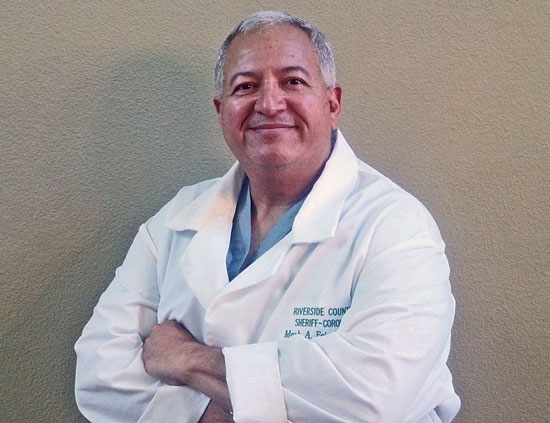
Highly skilled with a scalpel, L.A.'s new coroner will now have to become facile with the celebrity-struck media.
Dr. Mark Fajardo has done thousands of autopsies in the dozen or so years he has spent as a forensic pathologist with Riverside County. From Palm Springs retirees to meth addicts to the renegade former Los Angeles Police Officer Christopher Dorner, he has examined all walks of toe-tagged life.
Still, as the Board of Supervisors named him Los Angeles County’s new chief medical examiner-coroner on Tuesday, Fajardo acknowledged that L.A. has one kind of death to which he’ll have to become accustomed when he steps into the job in August.
“In Riverside County,” he says, laughing, “we run the gamut—except for the celebrities.”
Fajardo, 49, succeeds Dr. Lakshmanan Sathyavagiswaran, who will retire this year after more than 21 years in the position that has come to be viewed as perhaps the nation’s most public coroner’s job.
Marilyn Monroe’s death was investigated by the Los Angeles County Department of Coroner; so were Sen. Robert F. Kennedy’s and Sharon Tate’s and Janis Joplin’s and John Belushi’s and Notorious B.I.G.’s and Michael Jackson’s and Whitney Houston’s and the paparazzo who died earlier this year trying to get a photo of Justin Bieber.
So many high profile cases come through the department, in fact, that in some instances, they’ve boosted the coroner himself to star status. Between 1967 and 1982, Dr. Thomas T. Noguchi came to be known as the “coroner to the stars.”
“I haven’t had to interact with the press much at all, so this will be interesting,” says Fajardo, noting that he hopes to follow Sathyavagiswaran’s lead and delegate most of the media interaction to someone else in the department. Despite a nationally televised stint on the stand during the trial of O.J. Simpson, the current coroner came to be known less for his time in the spotlight than for his competence in rebuilding the department after Noguchi and his successor, Ronald Kornblum, left their jobs amid management lapses and critical audits.
Nonetheless, Fajardo says, when he visited the department, he and Sathyavagiswaran talked at length about the challenges of dealing with death, L.A.-style.
“He told me that you lose all privacy, that you might have any member of the press asking any question at any time, and that you have to be prepared to answer openly,” says Fajardo. “And we talked about the media’s involvement in the case of Michael Jackson. He said there was such a caravan of cameras and paparazzi that they had to utilize a helicopter just to get him from Point A to Point B.”
That said, Fajardo says he’s looking forward to the $275,000-a-year job, which brings him and his wife, a San Bernardino County employee, back to his hometown.
Born at LAC+USC Medical Center, he spent his childhood in East Los Angeles and Pico Rivera. When he was 12, his father, a Los Angeles County deputy sheriff, was killed in an automobile accident on the way to work, and the family moved to be near relatives in Santa Maria.
It was there, while Fajardo was in high school, that the door to his current career opened.
“I took a class at a local community college to learn how to be an EMT,” he recalls.
That skill helped pay his way through his undergraduate training and medical school at UC Davis, where he initially aspired to be an emergency room doctor.
“I actually ran the student clinic at UC Davis,” he remembers. “But the people I played basketball with were pathologists and the friendships I made led me down that path instead.”
At Riverside County, he says, he has performed more than 5,500 autopsies, including more than 350 homicide cases while managing seven full- and part-time pathologists and helping manage a department that handles some 11,000 cases a year.
“This is as far removed as you can get from what most people think of as working as a doctor,” says Fajardo. “But for me, every case is a puzzle I get to solve, hopefully in a way that gives their families closure. I speak for the dead. I try to answer the questions about how they lost their lives.”
Demographically, he says, his caseload isn’t much different than Los Angeles County’s.
“We have our share of homicides,” he says ruefully. “And we’ve had six officer-involved shootings in the last month.”
But while the Riverside County coroner’s operation is large by some measures, serving about 1.3 million people, its constituency is only a fraction of the size of L.A. County’s.
“To me, that’s probably the biggest challenge,” says Fajardo. “Ten million people and all of them have needs. And we have to meet them—we provide a service, just like sheriff’s deputies and firefighters. It’s just that, unless a celebrity dies, people just don’t notice us as much.”
Posted 7/9/13
The grandest opening of them all
October 4, 2012
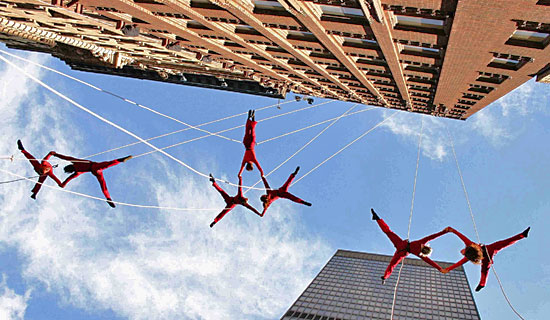
Bandaloop brings its aerial artistry to City Hall on Saturday, for the opening of Grand Park's final segment.
It’s been rolling out, bit by bit, since mid-summer, but this weekend, Grand Park will finally get the grand opening Los Angeles has been waiting for.
As the third and final section of the 12-acre space opens to the public, a festive block party is being planned on Saturday, October 6, from 4 p.m. to 9 p.m., with dancing around the fountain, Cuban jazz on the lawn, food trucks on the street and, at the park’s eastern boundary, a soaring aerial ballet up the sides of L.A.’s iconic City Hall. Then on Sunday, the park will leap into action as a hub for the wildly popular CicLAvia.
“It’s really exciting,” says Dawn McDivitt, who has managed the park project for the county’s Chief Executive Office. “The opening of the first two blocks in July drew 5,000 people in the first weekend, and we think this weekend will draw even more.”
Stretching from City Hall to the Music Center, the new park—an inviting 4-block rectangle of grass, plants, water and hot pink lawn chairs—has been drawing crowds since its first segment opened this summer, offering the first substantial stretch of green space in downtown L.A.
Conceived nearly a decade ago as part of a plan to redevelop Grand Avenue with luxury hotels, condos and retail, the park moved ahead while other elements were postponed by the economic downturn, largely because of a $50 million payment that was negotiated upfront from Related Cos., the project’s developer.
The first section, opened in July, is anchored by a Starbucks and the Arthur J. Will Memorial Fountain, which features an ankle-deep membrane pool that has become a major weekend draw for nearby families. The middle section features a community terrace with a Court of Flags, a Vietnam Memorial and 24 cherry blossom trees from the Japanese Consulate. The final section, at the City Hall end, will offer a dog park and a spacious event lawn that planners already are programming for local gatherings. Also on tap for the future is an anchor restaurant or café at the City Hall end of the park.
“I think if you ask anyone, the park is already a success,” says McDivitt, noting that none of the park events so far have drawn fewer than 200 to 300 people. “And when you compare that to the mall that was there before, where, if you saw 20 people in all three blocks, you were lucky—just looking out my window at the Hall of Administration, it’s amazing. People who have driven in from their communities for events, neighborhood people from the lofts, mothers sitting around the membrane pool with their children. There are more people than I’ve seen down there in 22 years of working here.”
This weekend’s kickoff is expected to draw crowds from throughout the county, starting with 11 a.m. dance lessons at the Music Center Plaza in a salute to Latino Heritage Month.
At 4 p.m., the Grand Park celebration will officially begin with “A Fanfare for Grand Park,” a reprise of a dance performance that premiered at the park’s July dedication.
At 5:30 p.m., down the hill on the park’s performance lawn, the Latin jazz duo Dos y Mas will launch the park’s new World Jazz Series, and at 6:45 p.m. outdoor videos will be projected onto the wall of the county’s Richard Neutra-designed Hall of Records building that flanks the park.
After a welcome from public official and dignitaries, the party will move to the event lawn. There, at 7:45 p.m., the aerial dance troupe Bandaloop will perform a spectacular vertical dance on the walls of the city’s towering City Hall building, suspended hundreds of feet off the ground by climbing ropes.
Park officials view Saturday’s celebration as just the start of Grand Park’s new role as a downtown centerpiece. Programming will be handled for the first three years by the Music Center, and Park Director Lucas Rivera has predicted the park will soon be home to farmers’ markets, arts festivals, book fairs, and other regional gatherings. McDivitt says she won’t be surprised to see regular movie nights, with outdoor films projected on the Hall of Records. Already, one segment of the park is home to the downtown speakers’ series Zócalo.
Events scheduled for the near term include an October 14 Pooch Party for dogs and the people who love them on the event lawn, an October 27 performance by the AXIS contemporary dance company, a November 2 night time Dia De Los Muertos party and a November 4 arts happening called Flash Fest.
Says McDivitt: “This really is a brand new chapter for downtown L.A.”
Posted 10/4/12
Taking Tiny for a ride
September 19, 2012

L.A. County dogs, especially small "fluffies" and Chihuahuas, are finding new homes around the country.
Los Angeles has plenty of big, famous exports: movies, food trends, celebrity gossip.
And at least one sought-after small one: the pint-sized rescue dog.
While dogs in Los Angeles County’s busy urban animal shelters can range from dachshunds to Saint Bernards, there’s an abundance of the little ones coveted by would-be adopters in other areas.
So a thriving pet transport circuit has sprung up. Since 2009, 3,457 L.A. County shelter dogs have found their way to Utah, Oregon, Montana, Colorado, Virginia and New York. Within California, they’ve hit the road for new homes in San Diego and Santa Cruz, with stops along the way at closer, less-crowded shelters in Irvine and Glendale. With 1,219 dogs transported so far this year, 2012 is the busiest yet for county canine relocations.
To land a quick home in another ZIP code, the transplanted L.A. dogs must be healthy, friendly and (generally) small. “Anything under 30 pounds, they’ll take. We could ship 5 Chihuahuas for every Labrador,” said Marcia Mayeda, the county’s director of Animal Care and Control. “It’s filling a void in their area.”
Because of the sheer size of its shelter population and the popularity of certain petite breeds here, Los Angeles County is able to share its canine wealth with places that have a shortage of adoptable small dogs.
The dog-moving operations have been funded by non-profit organizations like Best Friends Animal Society and the Heigl Foundation, established by actress Katherine Heigl.
Now the American Society for the Prevention of Cruelty to Animals is getting in on the act. With funding from New York philanthropist Carroll Petrie, ASPCA aims to save 16,600 dogs across the country in the next 8 months by helping to transport them out of crowded shelters. The Los Angeles County Board of Supervisors this week approved the county’s participation in the Carroll Petrie Foundation Dog Rescue Project. A subsidy of $50 per dog will allow the transfer of some 50 dogs a month from the county’s Downey Animal Care Center to the Mission Viejo Animal Services Department and, potentially, to other shelters as well.
The Chihuahua popularity boom—fostered by rampant media images of well-heeled pooches traveling around in celebutantes’ purses and stealing scenes in movies like Legally Blonde and Beverly Hills Chihuahua—contributed to overbreeding and a tiny-dog population explosion in L.A. and other California shelters in recent years. (On Tuesday, of the 1,521 dogs in Los Angeles County shelters, nearly a quarter—378—were Chihuahuas or Chihuahua mixes.)
Some highly-publicized relocation efforts, such as Project Flying Chihuahuas and Operation Chihuahua, have helped move hundreds of the little pooches from California to new homes around the country.
But now some areas are beginning to contend with a Chihuahua boom of their own, and have had to limit the number they accept.
Portland, for example, is “kind of saturated” with Chihuahuas these days, although the Oregon Humane Society still welcomes a twice-a-month shipment of other kinds of dogs from L.A., said Jennifer Barta, the agency’s “second chance” coordinator.
“Everybody here loves the L.A. dogs,” Barta said, marveling at how the transplanted pups endure “an incredibly long journey” yet still manage to come out wagging. “It’s just pretty phenomenal.”
Robin Harmon, “Pup My Ride” coordinator for the Best Friends group, has a good sense of what kinds of dogs are moving where.
A vanload of dogs that traveled from Los Angeles to Salt Lake City this week was “half Chihuahuas and a half what we call ‘fluffies’—poodle and terrier mixes,” Harmon said.
An upcoming shipment to New York, she said, will “probably have at least 30 Chihuahuas.” One of those L.A. expats will be going to the Hamptons, she said: “We’ve been laughing about that.”
An exception to the small dog rule: Billings, Montana, which Harmon said can be counted on to welcome four or five German Shepherds, along with other smaller dogs, from L.A. every couple of months.
Cats, alas, are another matter. “We are pretty well inundated with homeless cats of our own,” said Jessica Almeida of the Humane Society of Utah.
Even though the transport system can’t solve all the problems of homeless pets, redistributing the adoptable dog population makes it easier for conscientious consumers around the country to do the right thing when it comes to bringing home an animal.
“People want to go to a shelter,” said Mayeda, the county’s Animal Care and Control director. “They want to save a life.”

L.A. County shelters have plenty of Chihuahuas to share, but other areas, like Portland, are catching up.
Posted 9/19/12
Long may she wave—o’er Grand Park
September 6, 2012
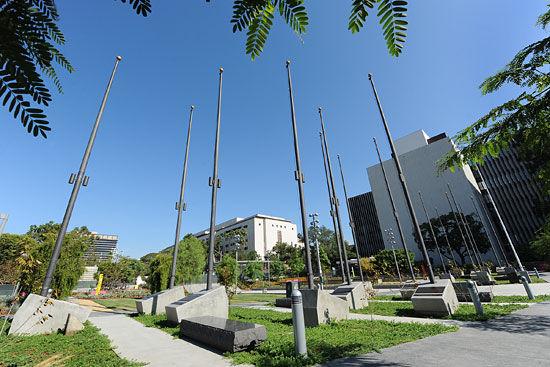
The historic flag court has been moved and positioned for higher visibility and more public space in Grand Park.
The next shiny, new section of Grand Park debuts Tuesday, but its centerpiece has been around for decades—although odds are you’ve never heard of it. Called “The Historic Court of American Flags,” it’s long been flying under the radar.
When the court was first completed in 1971, it featured 18 replica flags dating back to 1774, with plaques describing each one. The minimal landscaping surrounding the display served mostly as a cover for a four-level parking garage below. As far as public visibility, you’d be lucky to see more than a few stars and stripes from the neighboring streets.
Now, as the Grand Park Project gives the 12-acre space between the Music Center and City Hall a dramatic makeover, the flags have been uprooted from their original spot in the center of the park space and arranged parallel to Hill Street and Broadway. This not only vastly opened up the middle of the park’s third block but also gave the flags a more showy location.
Dawn McDivitt, the county’s project manager for Grand Park, said the flag court provides the community with “a space to reflect” on the nation’s—and the county’s—history. She said the county’s Department of Military and Veterans Affairs was consulted on the flags’ relocation and were “very, very pleased” with the results.
The flag court represents an effort by the designers to incorporate the area’s history with its future. A signature feature of the park, in fact, is the renovated Arthur J. Will Memorial Fountain, which, like the flags, was largely invisible to the public until two parking lot ramps were demolished and relocated.
The newest touch was the design of the concrete pedestals in which the poles and plaques have been mounted. Before, everything was cemented at ground level. Architects from Rios Clementi Hale Studios, which designed Grand Park, created the blockish pedestals so that the flags and plaques could be seen more easily, by more people.
The latest section scheduled for opening this week has been dubbed “Community Terrace.” Besides the court of flags, it boasts plants and flowers from all six floristic regions of the world, 24 cherry blossom trees from the Japanese Consulate, and, of course, the park’s movable magenta benches, chairs and tables. Terraced ramps will improve access to the area while offering extra seating capacity for large events once the final segment of the park near City Hall opens on October 6, just in time for the hugely popular CicLAvia to roll through the next day.
The Community Terrace is also home to theVietnam Memorial Monument, which features a bronzed Army helmet from the war’s era. The helmet had been sawed off and stolen twice over the years, so designers upgraded the monument with a threaded steel rod and other security measures to keep any would-be thieves at bay.
The terrace will open with a short ceremony on Tuesday, September 11 at 9 a.m. Bea Cohen, a 102-year-old World War II veteran recently honored by the Board of Supervisors, is expected to be on hand for the event. During the ceremony, the historic flags will be hoisted by veterans from all branches of the military, as well as by fire and law enforcement officials.
Posted 9/6/12




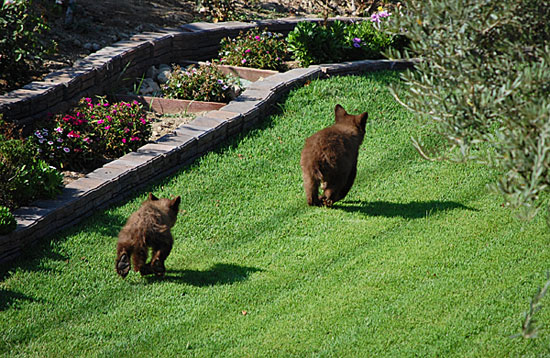

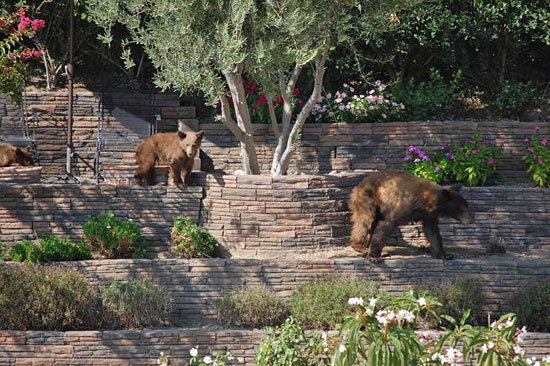
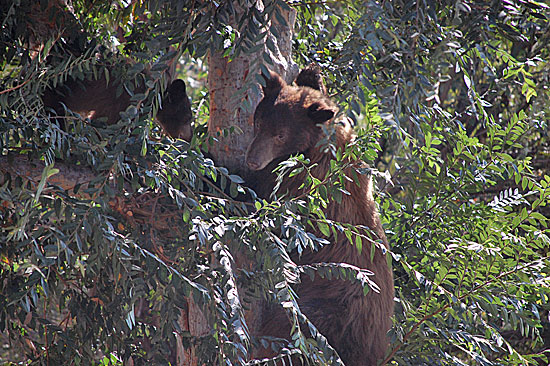
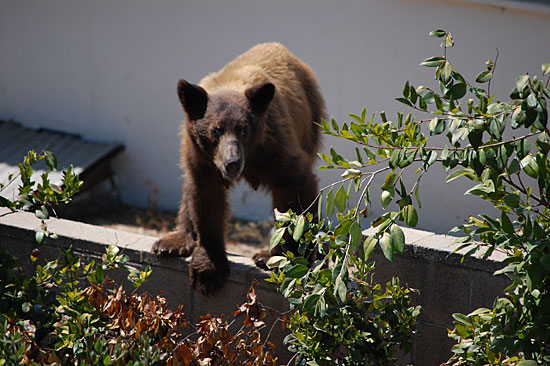


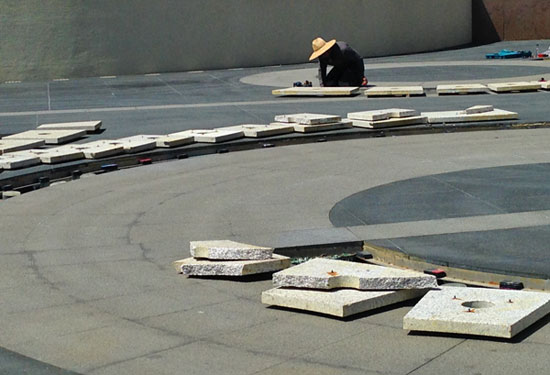
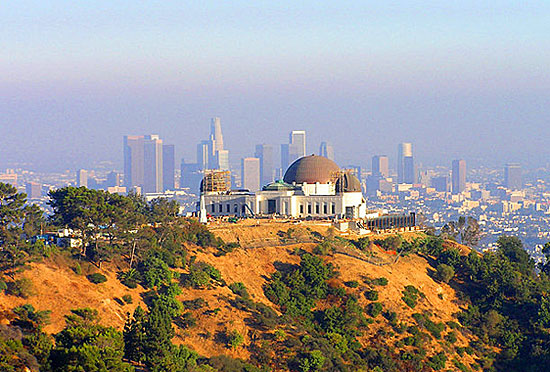
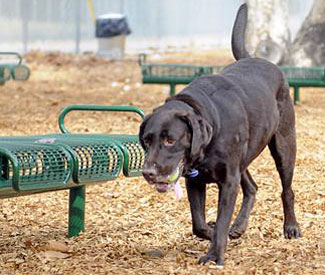

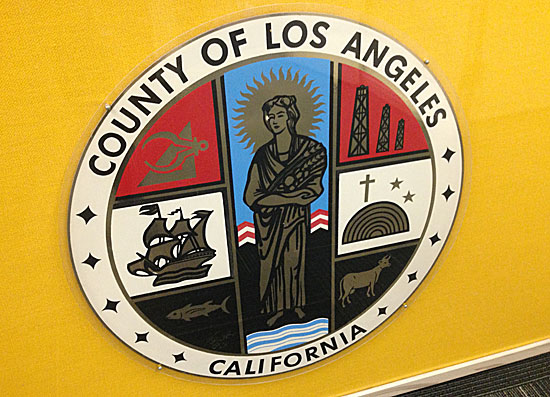
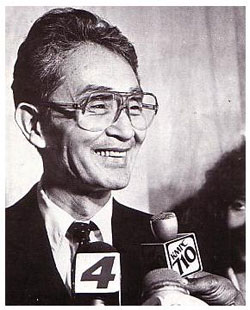
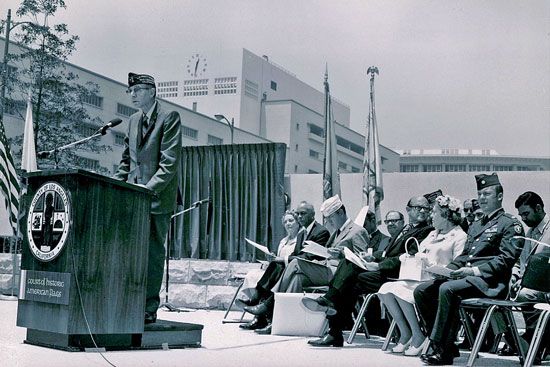







 405 bridge work causes a stink
405 bridge work causes a stink
